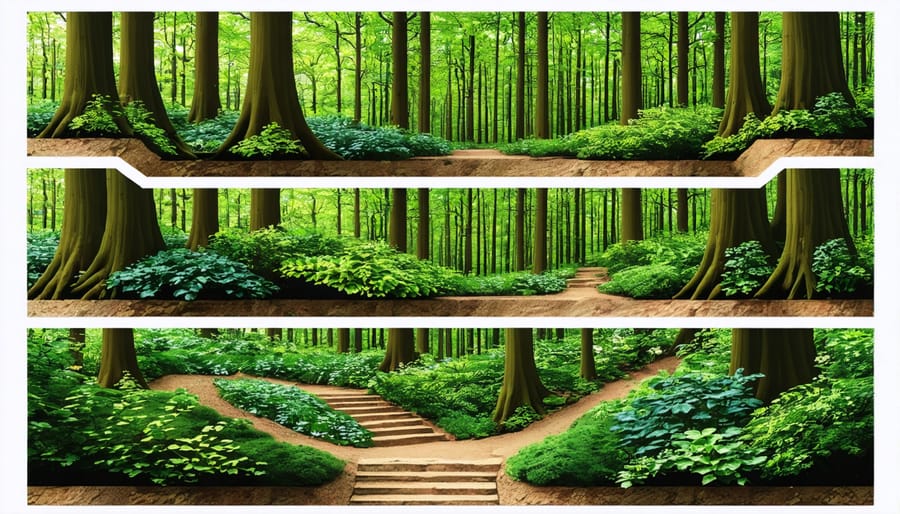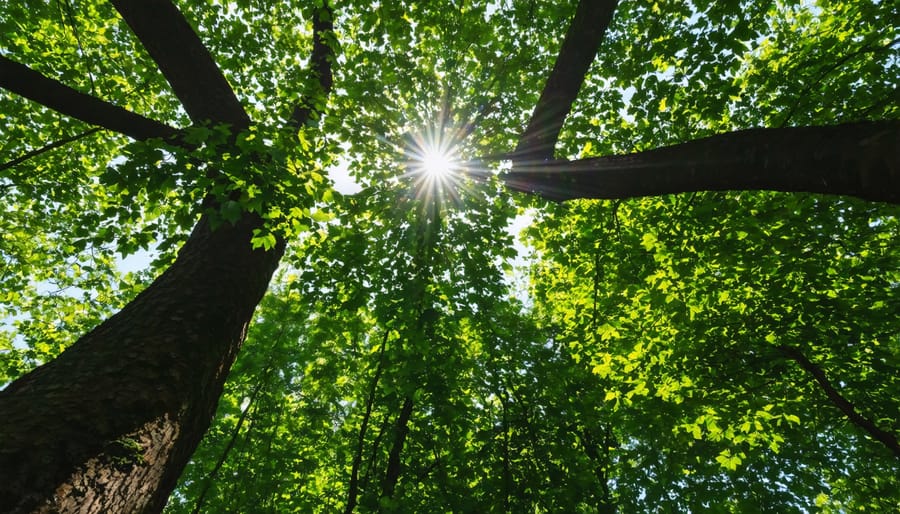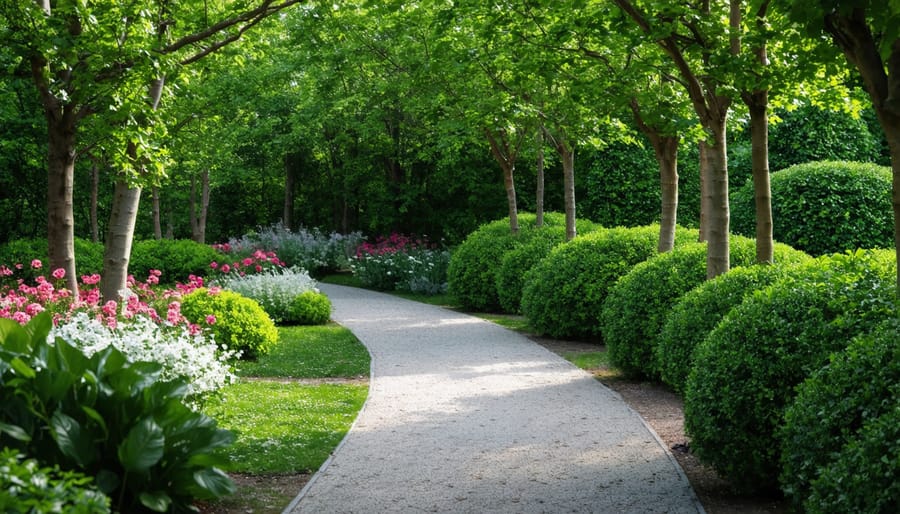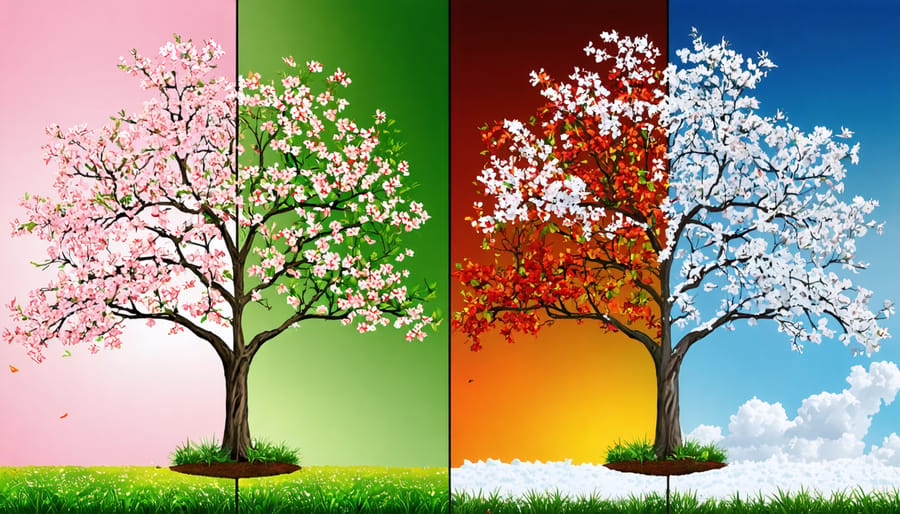Transform your garden into a living work of art by mastering the delicate balance between form and function. The art of planting aesthetic goes beyond simply arranging plants—it’s about creating a harmonious outdoor space that captures both natural beauty and personal expression. Whether you’re designing a serene shade garden beneath towering maples or crafting a vibrant cottage-style border, thoughtful plant selection and placement can turn any outdoor space into an enchanting retreat.
Modern planting aesthetics embrace the interplay of texture, color, and seasonal interest, while honoring sustainable gardening practices. By layering plants of varying heights, combining contrasting foliage, and incorporating year-round visual elements, gardeners can craft spaces that feel both designed and naturally evolved. This approach not only creates stunning visual impact but also supports local ecosystems and requires less maintenance over time.
Let nature be your guide as you explore the principles of aesthetic planting. Consider how light plays through leaves, how shadows dance across garden paths, and how plants move in the breeze. These elements, when thoughtfully combined, create gardens that don’t just grow—they tell stories, evoke emotions, and connect us more deeply to the natural world.
Planning Your Tree Garden’s Visual Story
Layer Your Plants Like Nature Does
Nature’s gardens grow in layers, and by mimicking this vertical structure, you can create a rich, dynamic landscape that’s both beautiful and sustainable. Think of your garden as a series of living stories, each playing a crucial role in improving your shade garden ecosystem.
Start with the tallest layer – your canopy trees. These majestic anchors provide essential shade and structure to your garden. Below them, understory trees and large shrubs create a middle layer that adds depth and interest. Think of flowering dogwoods or Japanese maples that thrive in dappled shade.
The shrub layer comes next, where you’ll find azaleas, hydrangeas, and rhododendrons creating a cozy middle ground. These plants bridge the gap between tall trees and lower-growing species, adding texture and seasonal color.
Herbaceous perennials form your next layer, filling the space with ferns, hostas, and woodland flowers. These plants create a tapestry of different heights and textures, keeping your garden interesting throughout the growing season.
Finally, don’t forget the ground layer. Creeping plants, moss, and low-growing perennials carpet the earth, preventing soil erosion and providing a finishing touch to your layered garden. This natural progression from tall to short not only looks stunning but also creates diverse habitats for beneficial wildlife.
Remember to consider each plant’s mature size when planning your layers, ensuring every plant has room to grow and thrive in its designated space.

Creating Year-Round Interest
Creating a garden that captivates throughout the year requires thoughtful planning and strategic plant selection. Start by choosing trees that offer multiple seasons of interest, such as Japanese maples with stunning spring foliage, summer shade, and brilliant fall colors, or river birch with attractive peeling bark that stands out in winter.
Layer your garden with companion plants that peak at different times. Early spring bloomers like hellebores and daffodils can flourish beneath deciduous trees before their leaves emerge. As summer approaches, shade-loving perennials like hostas and ferns create lush ground coverage, while astilbe adds pops of color with their feathery plumes.
For autumn drama, incorporate plants with striking fall foliage such as oakleaf hydrangeas or witch hazel. These shrubs provide structure and color when other plants begin to fade. Don’t forget winter interest – evergreen ground covers like pachysandra or winter-blooming plants such as witch hazel can keep your garden engaging during colder months.
Consider incorporating ornamental grasses that remain standing through winter, providing texture and movement. Berry-producing shrubs not only add visual interest but also attract birds, bringing life to your garden when everything else seems dormant. Remember to position plants so that as one variety fades, another takes center stage, creating a continuous display of natural beauty throughout the year.
Design Elements That Make Tree Gardens Pop
Playing with Light and Shadow
Light and shadow play a vital role in creating enchanting garden spaces, and mastering their interplay can transform your outdoor sanctuary. Dappled sunlight, created when light filters through tree canopies, adds depth and mystery while creating ever-changing patterns on the ground below. This natural light show not only enhances visual interest but also provides ideal growing conditions for shade-loving plants.
To harness this ethereal effect, consider planting trees with different leaf sizes and densities. Small-leaved trees like Japanese maples create delicate shadow patterns, while larger-leaved specimens like catalpa trees cast bold, dramatic shadows. Position these strategically to create interest throughout the day as the sun moves across the sky.
Embrace the beauty of contrast by incorporating light-colored plants or materials in shadowy areas. White-flowering plants like astilbe or silvery-leaved plants such as Japanese painted fern shine brilliantly in dappled shade. Consider adding light-colored gravel paths or pale stone features that catch and reflect available light.
For evening ambiance, integrate subtle landscape lighting to mimic natural dappled light patterns. Solar-powered lights placed among foliage can create beautiful shadow play after sunset, extending your garden’s magical atmosphere into the night. Remember that successful shadow gardening isn’t about eliminating shade but celebrating its presence and working with nature’s light show to create dynamic, living artwork in your garden space.

Texture and Form Combinations
Creating visual interest in your garden goes beyond color combinations – it’s about mastering the interplay of different textures and forms. Start by mixing plants with contrasting leaf shapes: pair the broad, smooth leaves of hostas with the delicate, feathery fronds of ferns. This contrast immediately adds depth and visual excitement to your garden beds.
Consider bark textures throughout the seasons. The peeling bark of river birch creates wonderful winter interest, while the deep furrows of oak bark provide a strong vertical element. Layer these with ornamental grasses that add movement and soft texture to your design.
Plant forms can be categorized into several basic shapes: upright (like columnar trees), mounding (think of rounded shrubs), spreading (ground covers), and architectural (such as plants with dramatic spikes or stems). Aim to include at least three different forms in each planting area to create a dynamic composition.
For maximum impact, place contrasting forms next to each other. Position tall, spiky plants like New Zealand flax behind rounded shrubs, or let trailing plants cascade over rigid, upright forms. Remember that texture can also come from hardscaping elements – incorporate rough stone walls or smooth pebble paths to complement your plant choices.
The key is balance – while contrast creates interest, too much variety can feel chaotic. Group similar textures in clusters before transitioning to different ones, creating a rhythm that guides the eye through your garden.
Color Strategies for Shade
Creating a vibrant garden in shaded areas requires thoughtful color selection and strategic plant placement. While sun-loving gardens often burst with bright blooms, shade gardens can be equally stunning when you understand how to work with different color palettes.
Start by embracing the natural beauty of foliage colors. Deep greens, silvery blues, and variegated leaves can create stunning visual interest even without flowers. Consider incorporating plants with white-edged or cream-striped leaves, which naturally brighten dark corners and create contrast.
For flowering options, focus on shade-loving plants that offer pops of color. White flowers are particularly effective in shade, as they reflect available light and appear to glow in dimmer conditions. Plants like white astilbe, bleeding hearts, and white-flowering hellebores create magical moments in shaded spaces.
Layer different color intensities to create depth. Place lighter-colored plants toward the back of shaded areas to create the illusion of more space, while positioning darker foliage in the foreground for definition. Consider incorporating plants with burgundy or purple leaves, like heuchera varieties, to add rich undertones that complement green foliage.
Remember that color doesn’t just come from flowers and leaves. Integrate decorative elements like light-colored mulch, pale stones, or strategically placed mirrors to reflect light and enhance your shade garden’s overall aesthetic appeal.
Practical Tips for Implementation
Spacing and Growth Patterns
One of the most common mistakes in garden design is underestimating how much space plants need when they reach maturity. While it might be tempting to pack plants closely together for immediate impact, proper spacing is crucial for long-term garden success and visual harmony.
When planning your garden, always check the mature size of each plant and add about 20% extra space for good air circulation. For instance, if a shrub grows to 4 feet wide, place it at least 2.5 feet from its neighbors. This spacing might look sparse initially, but your patience will be rewarded as the plants fill out naturally.
Consider creating layers with different growth patterns. Place taller plants in the background, medium-height plants in the middle, and ground covers or shorter plants in the front. This creates a natural progression and ensures smaller plants aren’t overshadowed as everything grows.
Remember that some plants grow faster than others. Fast-growing species can be spaced slightly farther apart, while slower-growing varieties might benefit from closer initial spacing. Use temporary fillers like annual flowers to occupy empty spaces while permanent plants establish themselves.
For a cohesive look, group plants in odd numbers – threes, fives, or sevens work particularly well. This creates natural-looking clusters that draw the eye through your garden design while maintaining proper spacing for healthy growth.
Maintenance for Beauty
Maintaining the aesthetic appeal of your garden requires regular attention and care, but don’t let that intimidate you! The key is to develop a consistent maintenance routine that helps your trees and plants flourish. To help your newly planted trees thrive, start with regular watering and mulching to establish strong roots.
Master the art of ornamental tree pruning by removing dead, damaged, or crossing branches during the dormant season. This not only maintains the desired shape but also promotes healthy growth. Remember to step back occasionally to assess your pruning work from different angles – this helps maintain balanced proportions.
Seasonal clean-up is essential for maintaining your garden’s visual appeal. Remove fallen leaves and debris regularly, and refresh mulch in spring and fall. Keep an eye on the spacing between plants, as overcrowding can disrupt your carefully planned aesthetic. Don’t forget to deadhead flowers and trim back perennials after blooming to encourage new growth and maintain a tidy appearance.
For trees and shrubs with specific shapes, gentle trimming throughout the growing season helps maintain their form without the harsh look of heavy pruning. Consider using clean, sharp tools to make precise cuts that heal quickly and don’t detract from the overall appearance of your garden.
Adding Non-Plant Elements
While plants are the stars of your garden, incorporating non-plant elements adds structure, visual interest, and year-round appeal to your outdoor space. Start with hardscaping elements like stone pathways, which not only create easy navigation through your garden but also add texture and permanent visual lines. Consider adding a decorative bench or garden seat – it’s not just functional but serves as a focal point and invitation to pause and enjoy your creation.
Water features, from simple bird baths to gentle fountains, bring movement and sound to your garden while attracting wildlife. Strategic lighting can transform your garden after dark, highlighting architectural plants and creating magical evening atmospheres. Solar-powered options make this both sustainable and easy to implement.
Decorative elements should complement, not overwhelm, your planting scheme. Garden art, whether it’s weathered metal sculptures, mosaic stepping stones, or ceramic pots, can add personality and color. Natural materials like driftwood, large rocks, or fallen branches can create organic sculptural elements that blend seamlessly with your plantings.
Remember to maintain balance – a good rule of thumb is to have these non-plant elements occupy about 20-30% of your visible garden space, letting your plants remain the primary focus while these elements provide structure and year-round interest.

Creating your own planting aesthetic is an exciting journey that combines personal expression with the timeless beauty of nature. As we’ve explored throughout this guide, achieving a stunning garden design isn’t about following rigid rules – it’s about finding the perfect balance between your vision and practical considerations. Remember that your garden is a living, breathing canvas that will evolve and mature over time.
Start small with a single area of your garden, experimenting with different plant combinations and design elements that speak to your style. Don’t be afraid to make adjustments as you learn what works best in your space. The most beautiful gardens often emerge from years of thoughtful cultivation and careful observation.
Whether you’re drawn to the clean lines of modern minimalism, the wild abundance of cottage gardens, or the zen-like tranquility of Japanese-inspired spaces, your authentic style will shine through in your plant choices and arrangement decisions. Keep sustainability in mind as you develop your garden, choosing plants that thrive in your local climate and support local wildlife.
Most importantly, enjoy the process. Gardening is as much about the journey as it is about the destination. Take photos of your progress, learn from both successes and challenges, and celebrate the seasonal changes in your growing space. Your garden will become not just a beautiful outdoor area, but a reflection of your personal aesthetic and a source of joy for years to come.




